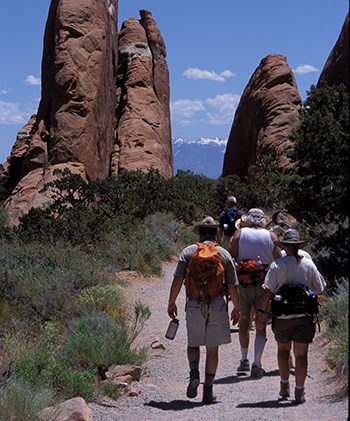Last updated: April 29, 2025
Article
Gnats

NPS/Neal Herbert
In the late spring and early summer, swarms of tiny biting gnats often greet visitors to Utah's national parks. Also called "midges," "no-see-ums," "punkies," and "moose flies," these miniscule pests thrive in the scattered pinyon-juniper forests of southeast Utah. Regardless of their name, it is no secret that a large population of these creatures can make outdoor activity unbearable.
Natural History
Biting gnats are parasitic organisms similar to mosquitoes and are capable of very annoying bites. However, while mosquitoes pierce the skin and feed with mouthparts similar to a hypodermic needle, biting gnats have scissor-like mandibles that cut the skin to produce a small, bleeding wound. In the process of biting, saliva penetrates the skin causing an allergic reaction. This reaction is minor in most people, though it can be severe in rare cases.
Only females bite since they require a blood meal to produce eggs. (Males feed on plants.) Gnats are active mostly during the day, especially around mid-morning and dusk. Biting usually peaks during a three-week period in late spring or early summer, and is usually more severe following droughts. Evidence of a bite may include itching, discomfort, and localized swelling. Anti-itch creams may alleviate discomfort. You can lessen your chances of being bitten by wearing long sleeves and pants. Repellents containing citronella may also be effective.
The life cycle of all biting gnats begins as an egg laid by the female shortly after mating. Males attempting to mate are especially harried as their sexual potency begins to decline eight hours after they pupate. A young male gnat takes about ten minutes to fertilize a willing female. However, as males reach 24 to 36 hours in age, copulation can take almost an hour. Females are intolerant of the advances of older males; they will resist mating with impotent males by flying away, kicking violently, and tipping their abdomens away.
Gnats deposit eggs in places that may become moist or flooded with spring rains. In canyon country, this includes mosses, soils, potholes, and the bark of Utah junipers and pinyon pines. Both eggs and larvae of some gnat species are tolerant of desiccation. They become inactive when their habitat dries and start their metabolic machinery again when rain moistens their home. Although larvae will pupate whenever they reach the appropriate stage if there is adequate water available, they may spend most of the summer, fall, and winter in their egg or larval stages. Adults often emerge from the pupal case after late spring or early summer rains.
Annoying as they are, biting gnats are an essential part of the web of life in canyon country. Many animals, including birds, fish, lizards, and other insects, depend on gnats as a food source.
